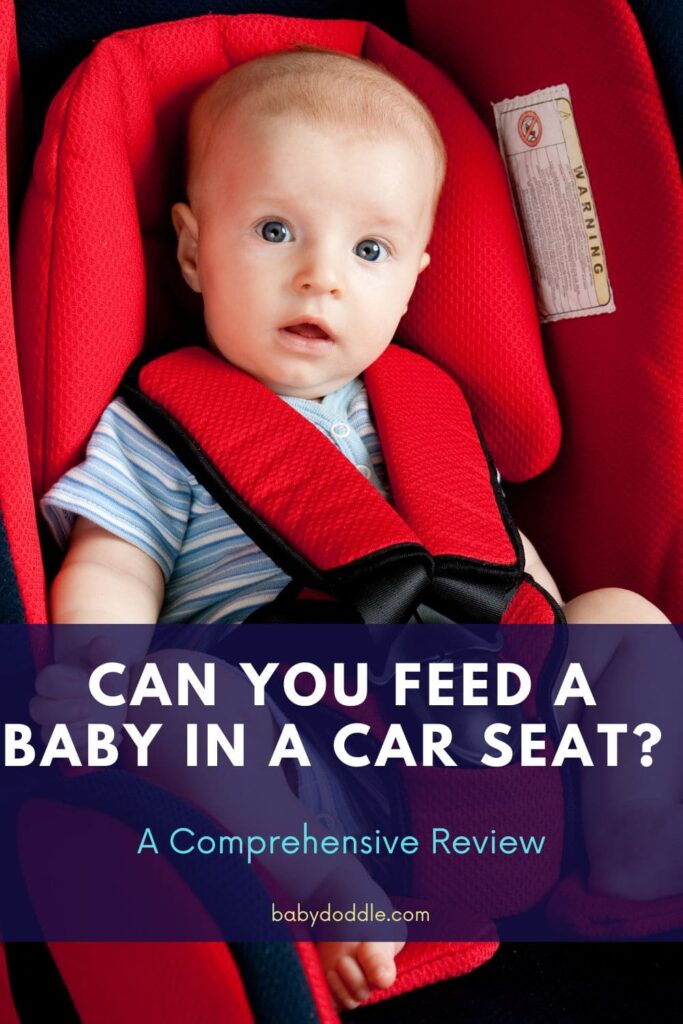As a parent who’s always on the go with my little one, I’ve definitely wondered, “can you safely feed a baby in a car seat?” It would make things so much easier when we’re out running errands or on a road trip if I could feed my baby while she’s strapped into her car seat! But is it recommended?
I decided to do some serious research on the ins and outs of feeding babies in car seats to answer that key question: can you feed a baby in a car seat? As a mom and a certified child passenger safety technician, I wanted to compile a thorough guide with safety tips, best practices, advice on what foods work, and more around feeding babies in car seats.
Is It Safe to Feed a Baby in Their Car Seat?
This is the million dollar question! After looking extensively into guidelines from pediatricians and other health bodies, the general consensus is that you can safely feed a baby in their car seat in many situations. However, there are certainly risks to be aware of.
According to the AAP, the biggest hazards with car seat feedings are:
- Choking – Babies reclined in car seats are at higher risk of choking. Sitting upright is safer for eating.
- Aspiration – Formula or breastmilk can be aspirated into the lungs if not swallowed properly.
- Strangulation – Loose straps could twist around baby’s neck.
- Distraction – Redirecting your attention from driving to feed baby.
So while the AAP doesn’t universally recommend against in-seat feeding, they emphasize it should be done with caution. Always put safety first.
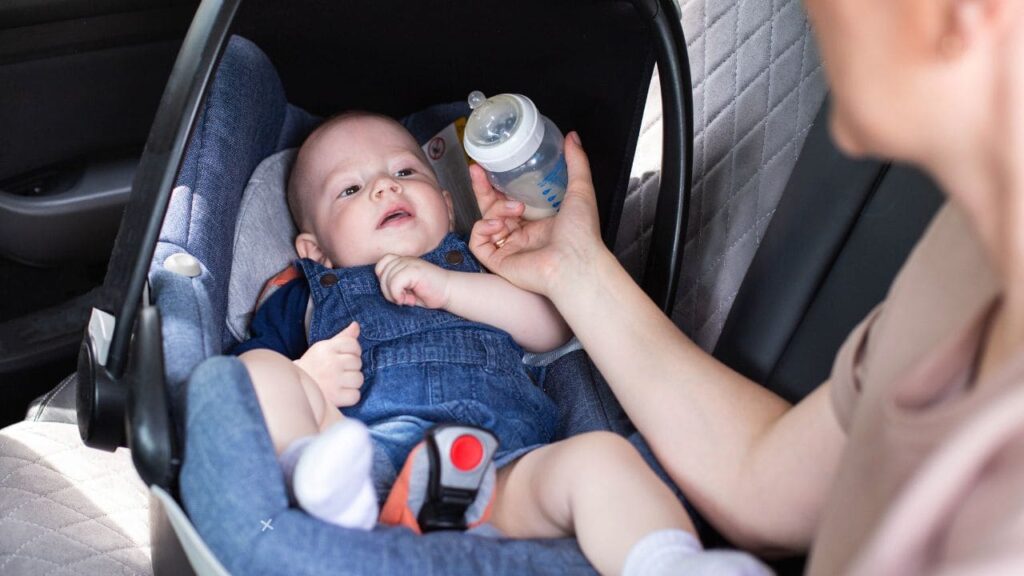
Tips for Safe In-Seat Feedings
If you do choose to feed baby in their car seat, follow these best practices:
- Supervise constantly – Actively watch for choking or other problems.
- Keep seat inclination approved for baby’s age – Check manual for details.
- Only feed when parked – Never while driving.
- Avoid unnecessary loose items – Toys, pillows, etc.
- Follow car seat manual guidelines – Don’t obscure buckles or straps.
- Stay stopped until feeding fully finished – Don’t start driving during.
I’ll get into more specifics below on how to feed safely in car seats by type of food, baby’s age, travel context, and other factors. But the overarching advice is: proceed with caution and care.
What Are the Benefits of Feeding Babies in Car Seats?
Assuming you follow safety precautions, there are some nice conveniences to feeding in car seats:
Easier for travel: You don’t have to fully unpack the diaper bag and find a spot to sit every time baby is hungry. You can feed on the go.
Helps with schedules: If you time feedings well, baby can eat while you’re driving which helps stick to naps and routines.
Entertainment for baby: The motion and activity of the car plus toys, mirrors, and music can keep baby occupied.
Supports development: Reaching & grasping for foods in the inclined car seat builds spatial awareness and motor skills.
More calming for some: The gentle vibration and snug fit of car seat can soothe babies during feedings.
Cleaner option: Containing the mess to the detachable car seat may be easier than cleaning restaurant high chairs or soiled clothes.
So when traveling or trying to make hectic days smoother, car seat feeding can be an asset in the right situations!
Challenges and Downsides of Car Seat Feedings
However, for as many perks as in-seat feeding offers, it also comes with distinct disadvantages to consider:
- Difficulty seeing baby’s cues – Harder to respond to fullness/hunger signals.
- Decreased head control – Can raise chances of choking on baby’s end.
- Uncomfortable for baby – Constraints of straps may irritate some babies.
- Messy cleanups – Spit up, spilled milk or purees make a sticky situation!
- Overfeeding risk – Not being able to clearly see how much baby has eaten already.
- Fussiness during changes – Transitioning baby out of the seat after a feeding might cause frustration.
As a mama who has been there, some babies simply don’t love being fed in their car seat too! So being willing to stop the car and take them out is a must.
Cleaning Up After Feedings
Even when taking all the right messy-minimizing precautions, car seat feedings inevitably involve spills, drips, splatters, and outright dumpings! Having a solid game plan for cleaning up afterwards makes life much, much easier.
Best Practices for Post-Feeding Car Seat Cleaning
- Assemble a designated car seat cleaning caddy to keep in your vehicle filled with all needed supplies. Stock up on cleaning wipes, paper towels, plastic bags, stain remover, hand vac, and extra car seat protector pads.
- Remove baby, then detach car seat from base if needed to clean every surface baby touched.
- Follow car seat manual guidelines for washing all detachable fabric pieces like harness straps and seat pads if excessively soiled. Let parts fully air dry before reattaching.
- For stuck on messes, scrape off solids with a dull knife or spoon edge then spot treat stains.
- Maintain by doing deeper periodic scrub downs and restocking cleaning caches as needed.
Having these post-feed tidy up routines established makes each future mealtime less intimidating. Save your back and your sanity!
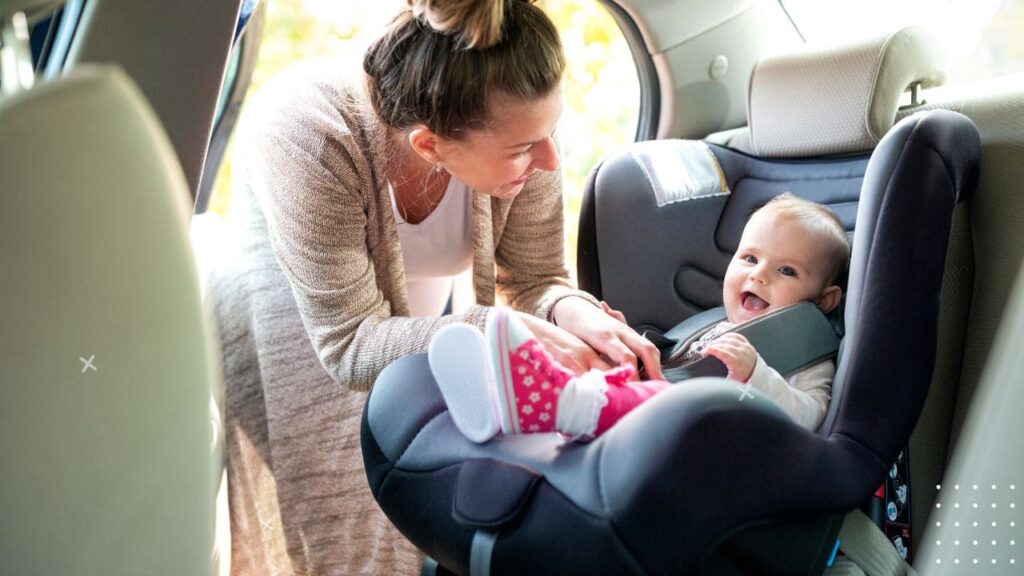
Deciding If Car Seat Feedings Are Right For You
Given the mix of upsides and downsides involved with feeding in car seats, it’s a very individual decision based on your baby’s needs and temperament.
If your little one seems to feed well on the go and doesn’t get overly frustrated in their seat, it may be a good option. But for babies who don’t love constraints or need more freedom of movement, traditional feedings might work better.
Pay close attention in the early months to how your baby responds. Having a willing participant makes all the difference!
Best Practices for Safe Car Seat Feedings
If you do opt to feed your baby in their car seat at times, following these best practice tips can help reduce the risks:
Secure car seat properly: Rocking or tipping during feedings raises injury risks. Verify car seat is tightly installed and baby properly buckled per guidelines. Consider middle rear seat if an option as most stable.
Add precautionary items: Use an approved car seat mattress protector and strap covers to catch spills. Car seat ponchos also help contain messes. Just don’t put anything behind or below baby that didn’t come with the seat!
Keep baby semi-upright: Follow car seat guidelines for appropriate recline. Newborns often need to stay at a 45 degree incline or greater because of airway risks.
Take it slow: Begin feeding with just a couple spoonfuls or small pieces to test out tolerance.
Use easy-to-grasp foods/cups: Finger foods, soft spouts with valves, and cups with straws or handles let baby access contents without much effort.
Have toys and activities ready: Distract baby with sights, sounds, and textures to make the experience more interesting. Just avoid loose items in the car seat itself.
Stop to burp: Since baby is reclined, you’ll need to remove them mid-way through feedings, hold upright, and burp before resuming eating.
Recommended Foods and Drinks for Car Seat Feedings
What you give baby during in-seat feedings is crucial. Here are the best options by food type:
Finger foods: Soft mashed fruits or steamed veggies, puffs, gentle meltable snacks that won’t break into chunks upon gummy chewing.
Purees: Single ingredient purees work better than mixed blends. Opt for thicker purees that won’t drip too quickly off the spoon.
Bottles: Slow flow nipples keep the liquid controlled. Breastmilk or formula both okay if pace feeding for small gulps only.
**Cups/reusable pouches:**valve-protected spouts, soft tipped straw cups, simple open cups ONLY for older babies who won’t tip contents out.
And always size up baby’s ability before introducing new textures or harder foods in the car seat!
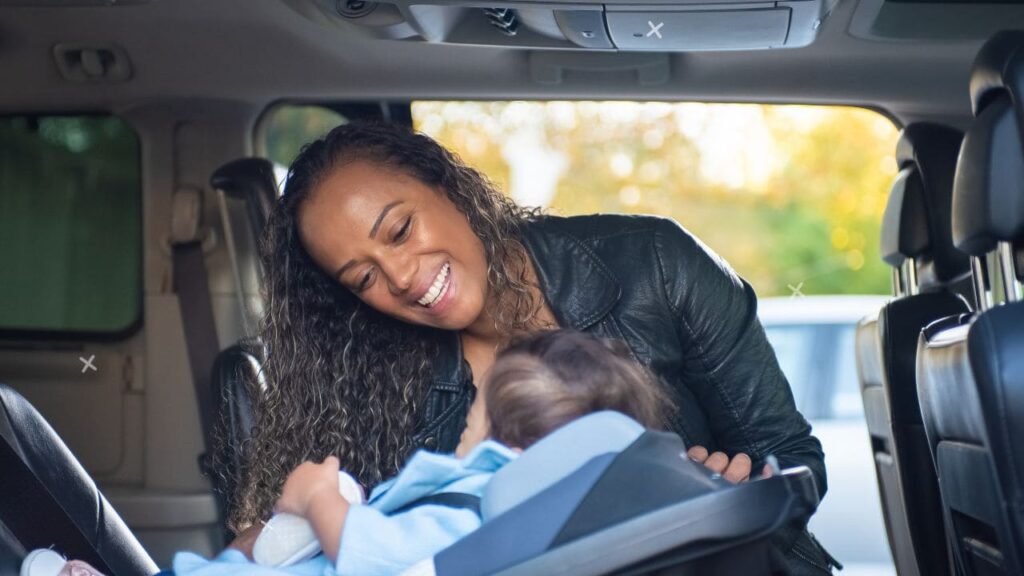
When to Avoid Feeding in Car Seats Altogether
While car seat feeding can be done safely much of the time if precautions are followed, there are situations where it is best avoided:
- Babies with respiratory issues or chronic lung problems
- Preemies and infants under 4 months
- Babies who’ve had breathing issues like apnea
- Babies with GERD or recurrent spit up
- If baby has a cold, cough, or stuffed nose
- For babies prone to upset stomachs or diarrhea
- When baby is overly tired or hungry (making choking risks higher)
Use your own judgment, but if baby is showing signs of head lag or lack of muscle control to manage solids, hold off on trying car seat feedings as well until they grow stronger. And when in doubt, consult with your pediatrician for personalized advice.
Special Considerations for Preemies and Multiples
Feeding preemies and multiples in their car seats requires extra planning and care. Preemies often have additional health concerns, making car seat feedings riskier. And coordinating feedings for two or more babies brings heightened challenges.
Tips for Feeding Preemies in Car Seats
- Follow your pediatrician’s guidance on safe feeding positioning and whether your baby’s airways and lungs can tolerate incline.
- Stick to the most reclined angle allowed in your infant seat and keep sessions very short.
- Allow extra time during feedings for pacing, burping, and monitoring breathing.
- Coordinate feedings with optimal times baby should be eating anyway to not disrupt schedules.
Tips for Feeding Multiples
- Consider staggering feedings slightly so each baby gets individualized attention.
- Use distinguishing car seat accessories like colored straps or name placards to identify babies. Having coordinating bibs, bottles, cups can help too.
- If you can, have another adult assist with feedings to tend to one baby while you handle the other.
- Accept it will be messy and difficult – don’t place too much pressure on smooth sessions!
Give yourself grace. Feeding one baby on the go is hard enough. Tackling preemie or multiples feedings requires advanced skill! Take it slow and steady.
Top Car Seat Feeding Gear and Accessories
If you plan to feed baby in their car seat routinely, investing in handy specialized gear makes the process easier:
- Car seat food tray – Attaches securely with suction or straps so baby has easy access.
- Backseat car mirror – Lets you make eye contact with baby to better gauge needs.
- Car seat travel mat – Catches fallen food and provides stain protection.
- Car seat toy bar – Gives baby something fun to look at and reach towards.
- Soft-spout sippy cups – Best cups to avoid major spills.
- Car seat travel utensils – Take along reusable food picks, plates, bowls and spoons .
- Window sun shades – Lets you see baby clearly without glare.
Taking advantage of key tools for eating and drinking while staying safely buckled in makes for happier, less messy car seat feedings all around!
| Accessory | Key Benefit |
|---|---|
| Car seat food tray | Lets baby self-feed while keeping hands contained |
| Backseat mirror | Allows you to monitor baby |
| Car seat travel mat | Catches spills to protect seat |
| Car seat toy bar | Entertains baby within view |
| Soft-spout sippy cups | Reduces risks of major spills |
| Car seat travel utensils | Brings plates, bowls, etc on the go |
| Window sun shades | Helps driver see baby clearly |
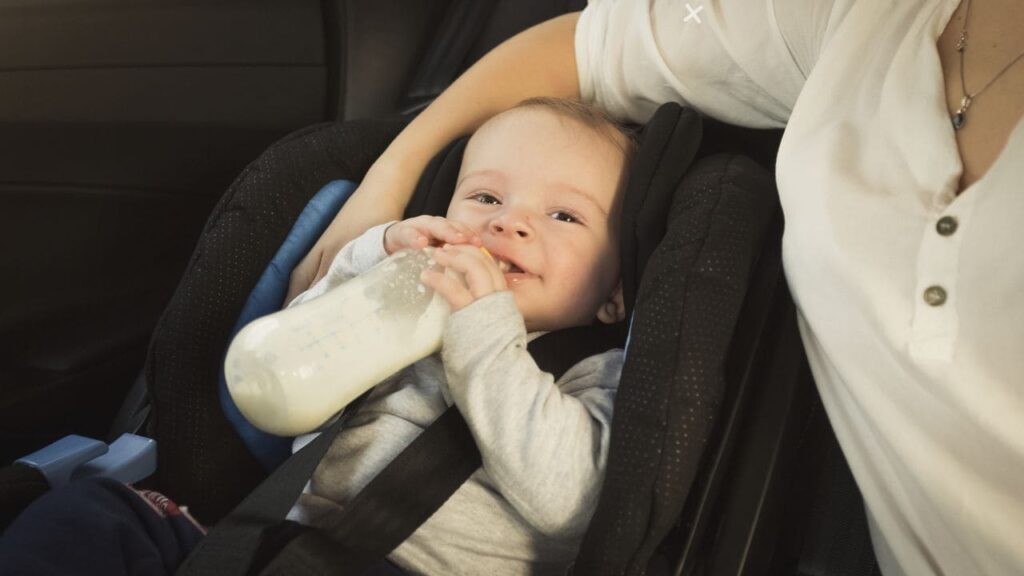
Car Seat Feeding Safety Guidelines By Age
What’s safe in terms of feeding position, foods, and other factors depends a lot on your child’s age and developmental stage. Here’s a quick overview:
Newborns
- Must stay semi-upright – usually 30 to 45+ degree incline
- Only bottled breastmilk or formula
- No solid foods
- Nothing but spill-proof cups with soft spouts/valves
4-6 months
- Can adjust to slightly more reclined angle per seat guidelines
- Can introduce pureed solid foods
- Begin working towards thicker purees
- Might begin holding own bottle
6-12 months
- Sitting at 90 degree angle is safest
- Can have mashed and finger food solids
- Grippy snacks okay in addition to purees
- Can hold own sippy cup or bottle
So tailor feeding approvals and precautions to where your baby is developmentally! And take your pediatrician’s advice on readiness for transitions.
| Age | Incline/Recline | Approved Foods | Approved Cups | Other Precautions |
|---|---|---|---|---|
| Newborns | 30-45+ degrees | Breastmilk or formula only | Soft spout cups, cups with valves | No solid foods, fully support head/neck |
| 4-6 months | Slightly more reclined per seat guidelines | Pureed solids | Sippy cups, bottles | Begin working on head/neck control |
| 6-12 months | 90 degree angle optimal | Mashed solids, finger foods | Open cups, grippier bottles/cups | Limit amount of loose snacks |
Over to You, Parents!
Hopefully this guide gave you thorough answers on whether or not feeding your baby in their car seat is recommended and best practices surrounding it.
- Remember, while possible if safety rules are followed, there are definite risks to be aware of first with choking, aspiration, and distractions.
- Tailor practices and precautions to your baby’s age and capabilities. And set both them and you up for success with the right tools!
- When in doubt, take baby fully out of the car seat before feeding – even if inconvenient. Their safety is what matters most!
Now that you know the full details, decide what approach feels right for your family. Here’s to less stressful feedings on the road! Let me know in the comments if you have any other car seat feeding questions.
FAQ – Can You Feed a Baby in a Car Seat?
Is it safe to feed solid foods to my baby in the car seat?
Feeding solid foods in the car seat generally isn’t recommended until baby is at least 6 months old and can sit up mostly unsupported. Even then small pieces and certain textures still pose choking risks. Fully mashed or pureed solids are safest in the 6-12 month range. Closely supervise any solid feedings and stay parked.
What about using those car seat tray attachments for eating? Are those safe?
Many car seat tray attachments that strap or suction onto the car seat claim to make feedings simpler. However, these trays have not been safety tested with car seats and could detach in crashes. They also bring loose items near baby’s face. For safest results, take baby out of the seat into a stationary highchair type seat with a secured tray instead.
Can I snack while driving if my baby is eating in the back seat?
It’s best not to eat your own snacks while baby is eating in their rear-facing car seat, even if you are tempted to! This divides your attention between focusing ahead on the road and monitoring your baby. Have your snacks later or pull aside to a complete stop first before eating, then resume driving after baby finishes.
Is it safe to breastfeed in a moving vehicle?
While some moms have mastered the art of breastfeeding in a moving car, most medical experts strongly advise against it. Not wearing a seatbelt to nurse baby greatly risks mom’s safety in a crash, as does the distraction posed. Safest practice is to fully stop the vehicle first before attempted feedings of any kind.
Can I feed baby food pouches in the car seat?
While messy, baby food pouches are generally safe for car seat feedings if the child is old enough developmentally. Ensure baby is sitting mostly upright and take occasional breaks to burp. Having pouches with handles instead of caps lets them self-feed more easily without choking risks. Open the pouch for them initially.
